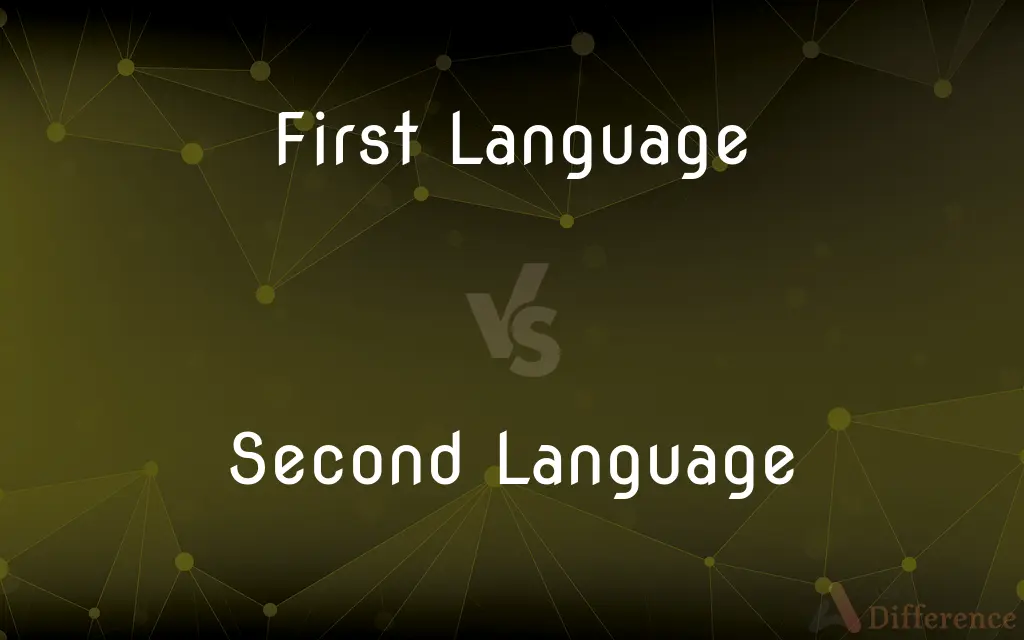First Language vs. Second Language — What's the Difference?
By Tayyaba Rehman — Published on January 12, 2024
A first language (L1) is the language learned from birth, often spoken at home and part of one's cultural identity, while a second language (L2) is any language learned after first, typically for communication in wider society or for specific purposes.

Difference Between First Language and Second Language
Table of Contents
ADVERTISEMENT
Key Differences
The first language, often referred to as the mother tongue, is usually acquired naturally in early childhood and is integral to personal and cultural identity. The second language is learned after the first language, often in a formal educational setting or through exposure to non-native environments.
L1 is typically characterized by proficiency and fluency, as it's developed during the critical period of language acquisition. L2, on the other hand, may require more conscious effort to learn, with varying degrees of proficiency depending on exposure, practice, and motivation.
The first language shapes the foundation of one's linguistic and cognitive development. The second language can influence cognitive processes differently and may even offer unique cultural perspectives and opportunities for personal or professional growth.
Mastery of L1 is often taken for granted due to natural acquisition, while mastery of L2 can be a significant achievement and a lifelong endeavor, with learners often facing challenges such as accent, idiomatic usage, and cultural nuances.
The use of the first language is typically more emotionally charged and instinctive, often used in personal and familiar contexts. The second language is frequently used for specific purposes, such as education, business, or travel, and may not carry the same emotional depth.
ADVERTISEMENT
Comparison Chart
Acquisition Method
Naturally acquired from birth.
Often learned through formal education or exposure.
Proficiency and Fluency
Typically high proficiency and fluency.
Varies; can range from basic to high proficiency.
Cognitive Impact
Fundamental to cognitive and linguistic development.
Influences cognitive processes differently; offers new perspectives.
Emotional Connection
Strong emotional and cultural ties.
Often more practical or utilitarian in nature.
Usage Context
Used in personal, familial, and cultural settings.
Used in broader social contexts, often for specific purposes.
Compare with Definitions
First Language
The first language is used instinctively and with emotional depth.
In emotional moments, she instinctively reverts to her first language, Russian.
Second Language
Learning a second language can offer new cultural and cognitive insights.
Studying Mandarin as a second language broadened his cultural understanding.
First Language
First language is the language learned naturally from early childhood.
Her first language is Spanish, as she grew up in Mexico.
Second Language
Used for communication in wider society or specific purposes.
In her career, she frequently uses her second language, German.
First Language
It's typically acquired without formal instruction.
She learned her first language, Italian, through family interactions.
Second Language
Second language is any language learned after the first language.
He learned English as a second language after moving to Canada.
First Language
It's often the language spoken at home and in one's community.
Although living in the U.S., his first language is Korean.
Second Language
Often acquired through formal education or exposure to new environments.
Her second language, French, was learned at school.
First Language
The first language shapes initial thought processes and cultural identity.
His first language, Arabic, influences his artistic expression.
Second Language
Second language proficiency varies based on learning context and practice.
Although not fluent, her second language, Japanese, is improving.
Common Curiosities
Can first language influence second language acquisition?
Yes, through transfer of linguistic structures and cognitive patterns.
Does knowing a second language affect first language proficiency?
Rarely, but some interference can occur, especially with less use of the first language.
Can cultural identity influence language learning?
Yes, cultural affinity can motivate and enhance language learning.
Is accent reduction important in second language learning?
Not necessarily; communication is often prioritized over accent.
Is it easier to learn a second language as a child?
Generally, yes, due to greater neural plasticity in childhood.
Can a person have more than one first language?
Yes, if they're raised bilingual, they can have multiple first languages.
Is fluency in a second language always achievable?
With dedication and practice, high levels of fluency can be achieved.
Can the first language influence the choice of a second language?
Yes, often through cultural, geographical, or familial connections.
Are there age limitations to learning a second language?
No, one can learn a second language at any age, though proficiency levels may vary.
Are there cognitive benefits to learning a second language?
Yes, including improved memory, problem-solving skills, and mental flexibility.
Can one's first language be forgotten?
It's rare but possible, especially if not used regularly.
How does bilingualism affect children’s development?
It often leads to cognitive advantages and greater cultural awareness.
Can learning a second language improve career opportunities?
Yes, it can open doors to international work and broaden professional networks.
Is it common to dream in a second language?
Yes, especially with increased proficiency and immersion.
Are language learning techniques the same for first and second languages?
They can differ, with second language learning often being more structured.
Share Your Discovery

Previous Comparison
Formic Acid vs. Acetic Acid
Next Comparison
Oracle vs. SQL ServerAuthor Spotlight
Written by
Tayyaba RehmanTayyaba Rehman is a distinguished writer, currently serving as a primary contributor to askdifference.com. As a researcher in semantics and etymology, Tayyaba's passion for the complexity of languages and their distinctions has found a perfect home on the platform. Tayyaba delves into the intricacies of language, distinguishing between commonly confused words and phrases, thereby providing clarity for readers worldwide.













































